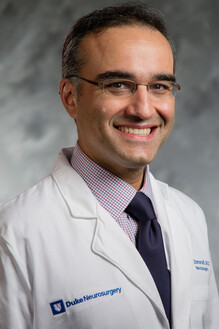 From the DukeHealth.org archives. Content may be out of date.
From the DukeHealth.org archives. Content may be out of date.
Treating Skull Base Tumors
Duke Combines Latest Technology with Personal Touch

Duke Health has the experience and advanced technology to treat hard-to-reach skull base tumors.
Lori Reedy, a middle school teacher in Raleigh, first noticed hearing loss in her right ear in the school dining hall. But the loss was so slight, it was easy to ignore. What she couldn’t ignore was the numbness she felt suddenly on the entire right side of her face. That, coupled with the hearing loss, led her to an ear, nose, and throat doctor, who first suspected an inner-ear virus. The doctor tried steroids, but they didn’t help. An MRI revealed a tumor of the balance nerve at the base of her skull that was the size of a ping-pong ball. The tumor, an acoustic neuroma, was benign. Yet, because of its size and critical location, it needed to be removed.
Benign but not Harmless
Though usually not malignant, skull base tumors are extremely challenging conditions to treat. The base of the skull separates the brain from vital sensory structures. It’s where vision, hearing, balance, smell, taste, facial movement, voice, and swallowing are all controlled. Tumors in this region are difficult for surgeons to reach, and can cause significant neurological problems.
Duke’s Skull Base Surgery Center offers comprehensive, sophisticated care for these hard-to-reach tumors. Duke surgeons perform these delicate procedures every week. The skull base program comprises specialists in neurosurgery, neurotology, otolaryngology, radiation oncology, and radiology. The doctors collaborate to devise an optimal treatment plan for each person. In Reedy’s case, because of the size of the tumor, surgery was the clear course of action.
Ask Questions about Treatment
Reedy’s tumor was pushing against her brain stem. When it was discovered in June 2012, it likely had been growing for some time. Calhoun Cunningham, MD, was her surgeon at the Skull Base Surgery and Cerebrovascular Center at Duke Raleigh Hospital. “Dr. Cunningham thinks, given the size of it, that it had been growing for 10 years,” she says. Being an educator, Reedy wanted to learn all she could about the procedure and any risks associated with it. “Dr. Cunningham prepared me thoroughly for everything I might be dealing with postsurgery,” she says. “He explained that the inner ear, along with sight and specialized muscles, help give you balance, and that I might have to work to regain mine. He showed me a special way to walk up the steps until I got my balance back. And he showed me exercises I could do at home.”
Cunningham says it’s important for people to ask questions of their doctors while discussing treatment options. “Ask about risks to the important structures of the skull base,” he says. “And definitely ask how many surgeries of this type your surgeon has performed. Some doctors perform just two or three of these a year. We occasionally perform that many in a week.”
Cunningham and Duke neurosurgeon Ali Zomorodi, MD, removed Reedy’s tumor during a seven-hour surgery. The feeling in her face returned almost immediately. “I had been worried that the right side of my face might droop,” she says. “That was one of the possible risks Dr. Cunningham mentioned. But that didn’t happen. And the numbness went away two or three days after surgery. I still can hear only minimally out of my right ear, and that’s permanent. But, hey, I can live with that.”
Although surgery was the right treatment for Reedy, in some cases observing the tumor closely may be the best option. “For some benign tumors, especially in older patients, we may watch and wait,” Cunningham has said. Medication to shrink the tumor can also be a common first step in treating skull base tumors, such as pituitary tumors.
Technology Matters
Reedy’s surgery at Duke Raleigh took place in the only biplane angiography (imaging) suite of its kind. The biplane angiography captures X-ray images from two different planes, or angles, allowing doctors a clear visualization of the area. Biplane technology procedures are less invasive and less risky than the traditional open approach, which often requires several large incisions. The endovascular surgical approach involves accessing the area through blood vessels starting in the groin.
Even with all the advanced equipment and highly skilled surgeons, Cunningham says one of the best aspects of the skull base program at Duke Raleigh is something basic. “Our patient navigator coordinates every aspect of care for our patients and his or her family.” The navigator is a trained nurse who helps guide patients through each stage of the process, from initial questions and a consultation through a hospital stay, if surgery is needed.
It’s the latest technology combined with personal care that sets Duke’s skull base center apart. Treatment for skull base tumors is available at Duke University Hospital and Duke Raleigh Hospital.




